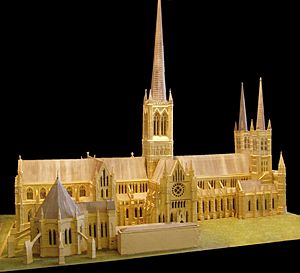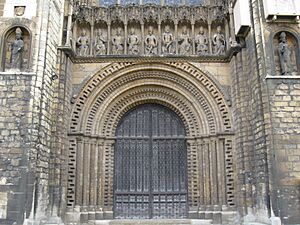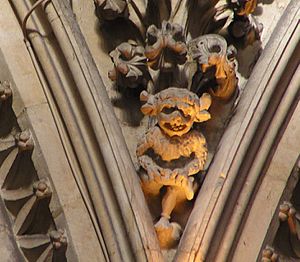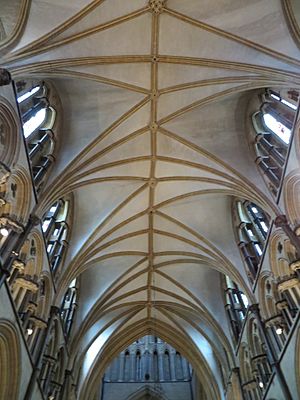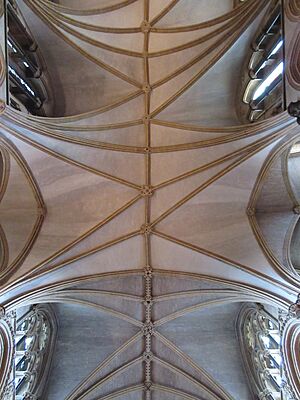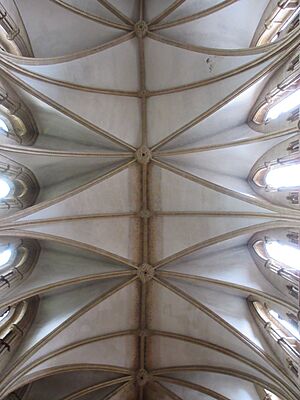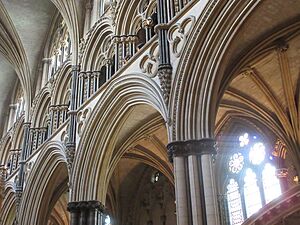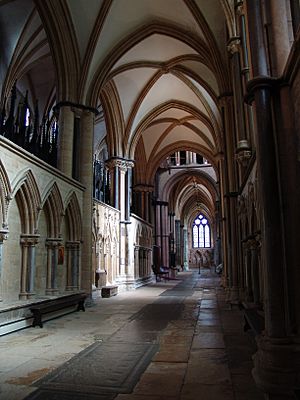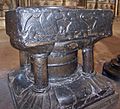Lincoln Cathedral facts for kids
Quick facts for kids Lincoln Cathedral |
|
|---|---|
| The Cathedral Church of the Blessed Virgin Mary of Lincoln | |
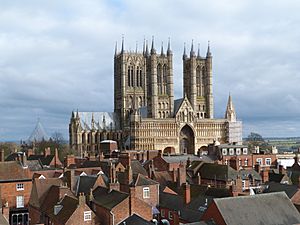
Lincoln Cathedral viewed from Lincoln Castle
|
|
| Lua error in Module:Location_map at line 420: attempt to index field 'wikibase' (a nil value). | |
| Location | Lincoln, Lincolnshire |
| Country | England |
| Denomination | Church of England |
| Previous denomination | Roman Catholicism |
| Tradition | Anglo-Catholic |
| History | |
| Dedication | Virgin Mary |
| Consecrated | 11 May 1092 |
| Architecture | |
| Style | Gothic |
| Years built | 1185–1311 |
| Groundbreaking | 1072 |
| Specifications | |
| Length | 147 metres (482 ft) |
| Width | 24 metres (78 ft) |
| Nave height | 24 metres (78 ft) |
| Number of towers | 3 |
| Tower height | 83 metres (272 ft) (crossing) |
| Number of spires | 3 (now lost) |
| Spire height | 160 metres (520 ft) (crossing tower) |
| Bells | 13 hung for change ringing; 20 in total (13 in South West tower, 2 in North West tower and 5 in the central tower) |
| Tenor bell weight | 23cwt 3qr 23lb (1212 kg) in D |
| Administration | |
| Diocese | Lincoln (since 1072) |
| Province | Canterbury |
Lincoln Cathedral, also known as Lincoln Minster, is a famous Church of England cathedral in Lincoln, England. It is the main church for the diocese of Lincoln and is where the bishop of Lincoln has his official seat. The cathedral is a very important Grade I listed building, meaning it's protected for its special history and architecture.
Construction on the earliest parts of the cathedral began in 1072. It was finished in 1092 but was badly damaged by an earthquake in 1185. Over the next centuries, it was rebuilt in the beautiful Gothic style. In 1311, when its central spire was completed, Lincoln Cathedral became the tallest building in the world. It was even taller than the Great Pyramid of Giza! This record lasted until the spire fell down in 1548 and was never rebuilt.
Today, the cathedral holds one of the four original copies of the Magna Carta, a very important historical document. This copy is now kept safely in Lincoln Castle. Lincoln Cathedral is also the fourth largest cathedral in the UK by floor area. Many experts admire its architecture. The famous Victorian writer John Ruskin once said it was "the most precious piece of architecture in the British Isles."
Contents
History of Lincoln Cathedral
Building the First Cathedral
The first Bishop of Lincoln, Remigius de Fécamp, moved his main church (called an episcopal seat) to Lincoln between 1072 and 1092. He started building the cathedral in 1072. Since he was from Normandy, he likely used Norman builders. He died in 1092, just two days before the cathedral was officially opened.
Before this, the church of St Mary's in Stow was considered the most important church in Lincolnshire. However, Lincoln was a better central location for the diocese, which stretched from the River Thames to the Humber.
Fire, Earthquake, and Rebuilding
In 1124, a fire destroyed the wooden roof of the cathedral. Bishop Alexander of Lincoln rebuilt and made the cathedral bigger. But about 40 years later, in 1185, a large earthquake severely damaged it. This earthquake was one of the biggest ever felt in the UK.
The earthquake caused a lot of damage. People said the cathedral "split from top to bottom." Today, only the lower part of the west end and its two towers remain from the church built before the earthquake.
St Hugh's Rebuilding Project
After the earthquake, a new bishop named Hugh de Burgundy of Avalon, France was appointed. He became known as St Hugh of Lincoln. He started a huge project to rebuild and expand the cathedral.
Rebuilding began with the choir (called St Hugh's Choir) and the eastern transepts between 1192 and 1210. The main part of the church, the nave, was then built in the Early English Gothic style. Lincoln Cathedral quickly adopted new building ideas of the time, like pointed arches, flying buttresses, and ribbed vaulting. These features helped support larger windows.
Adding Windows and Towers
The cathedral has two large rose windows made of stained glass. These are called the Dean's Eye and the Bishop's Eye. The Dean's Eye, on the north side, was part of the 1192 rebuild and finished in 1235. The Bishop's Eye, on the south side, was rebuilt about a hundred years later in 1330.
A record from that time explains the meaning of these windows. The north side represents the devil, and the south side represents the Holy Spirit. The bishop's eye faces south to welcome good, and the dean's eye faces north to turn away evil.
In 1237, the main tower of the cathedral collapsed. A new tower was started soon after. In 1255, the cathedral asked King Henry III of England for permission to expand the building. This included rebuilding the central tower and spire and adding a larger east end to handle more pilgrims visiting St Hugh's shrine.
Between 1307 and 1311, the central tower was made taller, reaching its current height of 271 feet (83 m). A very tall wooden spire covered in lead was added to the central tower. This spire was blown down in a storm in 1548 and was not rebuilt. With this spire, the tower was believed to be 525 feet (160 m) tall, making it the tallest structure in the world at that time.
Around 1380, the western towers were also made taller. They had wooden spires covered with lead added in 1420, but these were taken down by 1807.
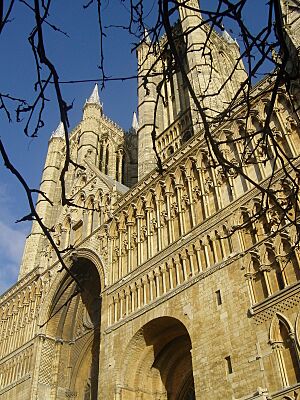
Later Additions
Other additions to the cathedral included its detailed carved screen and the 14th-century misericords (small ledges on choir stalls). The Angel Choir was also added.
In 1398, John of Gaunt and Katherine Swynford started a special chapel in the cathedral to pray for their souls. In the 15th century, more chapels were built, often as memorials. These chapels, especially those next to the Angel Choir, were built in the Perpendicular style, known for its strong vertical lines.
The Magna Carta at Lincoln
Hugh of Wells, who was Bishop of Lincoln, was one of the people who signed the original Magna Carta. For many years, Lincoln Cathedral kept one of the four remaining copies of this important document. It is now safely displayed in Lincoln Castle.
The Lincoln Magna Carta was even shown at the 1939 New York World's Fair. During World War II, the British government thought about giving it to the United States because of how many Americans wanted to see it. In 2009, the Lincoln Magna Carta was loaned to the Ronald Reagan Presidential Library in California.
The three other original copies are at the British Library and Salisbury Cathedral.
Special Features of the Cathedral
The Lincoln Imp
A small carving in the Angel Choir is famous as the Lincoln Imp. Since the late 1800s, it has become a symbol of the city. The carving is from the 13th century. It became well-known after a poem called "The Ballad of the Wind, the Devil and Lincoln Minster" was written about it.
Wren Library
The Wren Library inside the cathedral holds a rare collection of over 277 old manuscripts. This includes writings by the famous historian Venerable Bede.
Rose Windows
Lincoln Cathedral has two large rose windows, which are quite rare in medieval English cathedrals. The "Dean's Eye" is on the north side and is part of the original building. The "Bishop's Eye" is on the south side and was likely rebuilt around 1325–1350.
The Bishop's Eye is a great example of "curvilinear tracery" in medieval architecture. This means the patterns are made of continuous curves. Designing a circular window with these curves was a challenge, so the designers divided the circle into smaller sections. This made it easier to create the beautiful curved patterns.
Unlike many cathedral windows of that time, which showed many colorful Bible stories, the Lincoln rose windows have fewer images. Some images you can see include saints Paul, Andrew, and James.
Unique Vaults
One of the most interesting architectural features of Lincoln Cathedral is its vaults (the arched ceilings). They are known for being both original and experimental. The vaults are different in the nave, aisles, choir, and chapels.
For example, in the North Aisle, there's a continuous ridge rib that goes across the sections. In the South Aisle, the ridge rib is broken up, highlighting each section. The North West Chapel has four-part vaults, while the South Chapel's vaults come from a single central column. The use of sexpartite vaults (six-part vaults) allowed more natural light to enter through the upper windows.
Saint Hugh's Choir has unusual asymmetrical vaults. They look almost like a diagonal line made by two ribs on one side and only one rib on the other. This pattern divides the space in a unique way.
The chapter house, a ten-sided building, has a single central column from which twenty ribs spread out, creating a very unusual vaulted ceiling. Each area of Lincoln Cathedral can be recognized by its unique vaults. These vaults are believed to be the work of a French-Norman master builder named Geoffrey de Noiers.
Tower Clock and Bells
A clock was first installed in the north-west tower in 1775. It was later moved to the central tower around 1835. In 1880, a new clock was built by Potts and Sons of Leeds. This clock included the famous Cambridge Chimes. The clock mechanism is very heavy, weighing about 4 tons! It strikes the Great Tom bell for the hours.
The South West tower of the cathedral has a beautiful set of 13 bells, all made by John Taylor and Co. The largest bell, called the tenor, weighs over 1.2 tons! The bells are rung from a special chamber in the tower.
Modern History of the Cathedral
Wartime History
During World War II, Lincolnshire was home to many airfields for the RAF Bomber Command. Because of this, the area was nicknamed "Bomber County." The badge for the nearby RAF Waddington shows Lincoln Cathedral rising through the clouds.
For safety during the war, "priceless British treasures" were hidden in a chamber 60 feet beneath the cathedral. However, the cathedral's copy of the Magna Carta was not there because it was on loan in the United States.
21st Century Renovations
In the early 2000s, a major renovation of the West Front (the main entrance) took place. Builders found that the flying buttresses on the east end were no longer properly connected to the stone. Repairs were made to prevent a collapse.
Also, the stonework of the Dean's Eye window was crumbling. This meant the window had to be completely rebuilt. It was a worrying time because if the stonework shifted just 5 millimeters, the entire window could collapse! Engineers carefully removed the window's tracery (the stone patterns) and put in a stronger, more stable replacement. The original stained glass was cleaned and protected behind new clear glass. This renovation finished in April 2006 and cost £2 million.
In January 2020, archaeologists announced that they had found over 50 burials during renovations since 2016. This included a priest buried with a chalice and paten (a small plate). They also found a coin from the time of King Edward the Confessor (1042-1066). Sections of Roman buildings and other ancient objects were also discovered. Some of these Roman, medieval, and Saxon items were planned to be displayed at a new visitor center. In 2022, the scaffolding was removed from the west front after 36 years of work.
Maintaining the cathedral costs about £5.86 million each year. The cathedral is a popular place to visit, especially during the Lincoln Christmas Market. Visitors can explore the nave for free or pay to take tours of the cathedral, the tower, and even the roof.
Cathedral Stone
Lincoln Cathedral is special because it is built mostly from stone taken from the ground it stands on. This stone is called Lincolnshire Limestone. The cathedral has owned its own quarry (a place where stone is dug out) since 1876. The stonemasons who work on the cathedral use over 100 tonnes of stone each year for repairs and upkeep.
Music at the Cathedral
Choir and Organists
The cathedral choir is made up of adult singers and two teams of about 20 girls and 20 boys. Lincoln was one of the first cathedrals in England to have a separate girls' choir, starting in 1995. Both the girls' and boys' choirs have the same musical opportunities and singing duties. The children in the choir come from many different local schools.
The director of music is Aric Prentice, who leads the boys' and men's choir. Jeffrey Makinson is the Cathedral Organist and assistant director of music, leading the girls' and men's choir. Famous organists who have worked at Lincoln Cathedral include the Renaissance composers William Byrd and John Reading.
The Organ
The cathedral organ is a very important example of the work of "Father" Henry Willis, a famous organ builder. It was the last organ he designed before he died, and it dates from 1898. Willis wanted the organ to be powered by electricity, which would have been the first in an English cathedral. However, the power station wasn't ready, so soldiers from the Lincolnshire Regiment had to power it by hand!
The organ has been restored twice, in 1960 and 1998. It is one of only two Willis organs in English cathedrals that still has its original sound design.
Burials and Memorials
Many important people are buried at Lincoln Cathedral. These include several Bishops of Lincoln, such as Remigius de Fécamp who started building the cathedral, and St Hugh of Lincoln.
Queen Eleanor of Castile, the wife of King Edward I, died in Lincoln in 1290. Her internal organs were buried in the Angel Choir of the cathedral, and a special tomb was built there to honor her.
Other notable people buried here include Katherine Swynford, the wife of John of Gaunt (a son of King Edward III), and Joan Beaufort, Countess of Westmorland.
The cathedral also has memorials to other important figures, such as Air Vice Marshall Sir Edward Arthur Beckton Rice and the historian Rev Charles Wilmer Foster.
Lincoln Cathedral in Media
In Films
Lincoln Cathedral has been used as a filming location for several movies. It stood in for Westminster Abbey in The Da Vinci Code (2006), as Westminster Abbey did not allow filming. Most of the filming took place in the cloisters and chapter house. To make it look like Westminster Abbey, murals were painted over the walls, and fake monuments were set up.
The cathedral also doubled as Westminster Abbey for the film Young Victoria (2009) and again for the Netflix film The King (2019). In 2022, the cathedral was one of the locations for the 2023 Ridley Scott film Napoleon.
Images for kids
-
12th-century carving of Adam and Eve eating apples
-
Typical Norman 12th-century decoration on the west front
See also
 In Spanish: Catedral de Lincoln para niños
In Spanish: Catedral de Lincoln para niños


